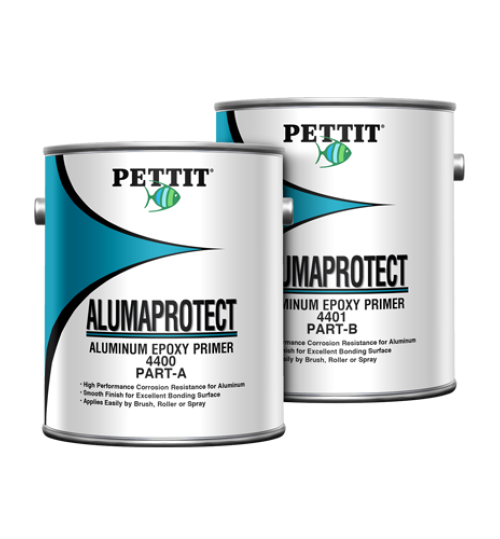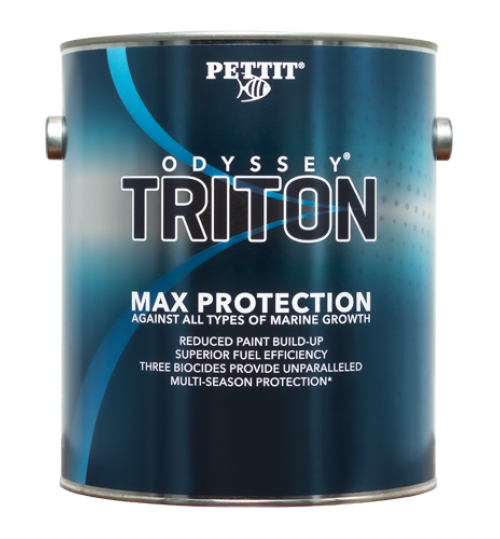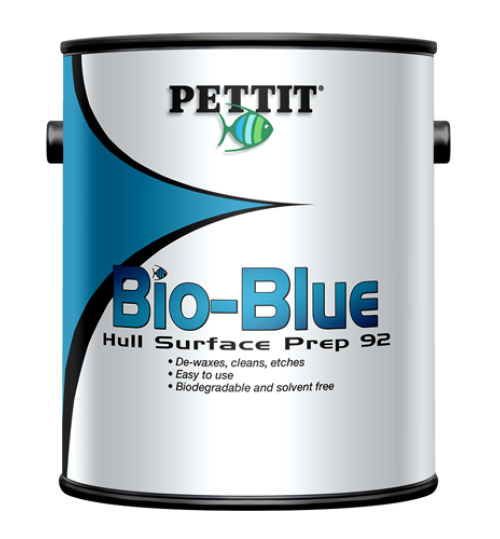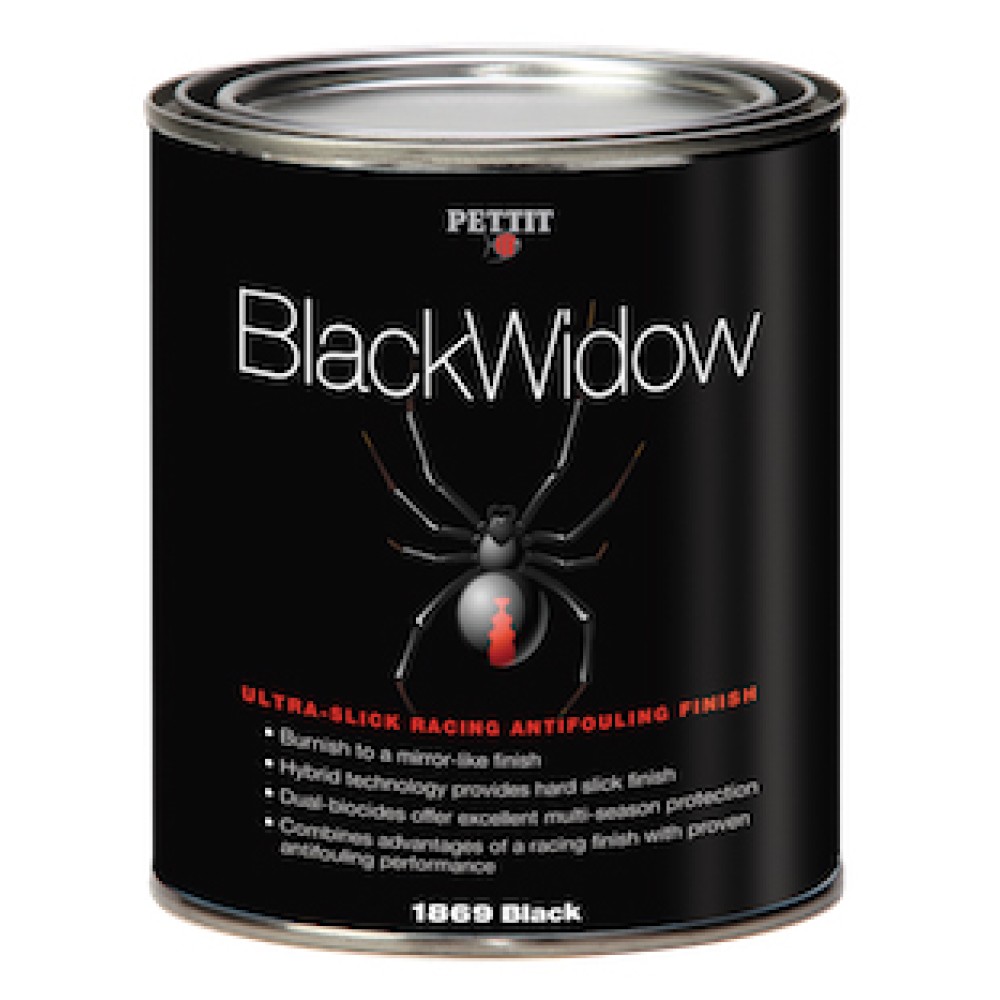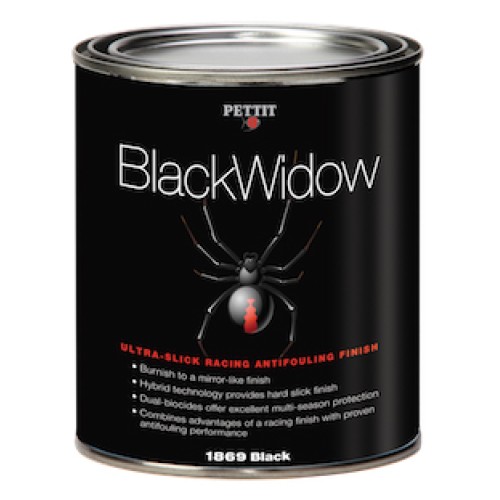
Pettit Black Widow Racing Antifouling, Black
-
Boat Bottom Paint
- Top Performing Bottom Paint
- Self-Polishing-Ablative Bottom Paint
- Hard Bottom Paint
- Hybrid Bottom Paint
- Water Based Bottom Paint
- Aluminum Safe Bottom Paint
- Bottom Paint Primers
- Specialty Marine Coatings
- Outdrive Paint
- Sea Hawk Paints
- Blue Water Bottom Paints
- Interlux Bottom Paint
- Pettit Bottom Paint
- Bottom Paint Remover
- Aquagard Bottom Paints
- Cleaners-Reducers-Solvents
- Boat Paint
- Boat Zincs
- New Items and Specials
- Boat Bottom Paint3
- Fiberglass and Gel Coat Repair
-
Topside Boat Paint
- Above or Below the Waterline
- Aluminum Boat Paint
-
Awlgrip Marine Paint
- Awlgrip Polyester Urethane Topcoat
- Awlcraft 2000 Acrylic Urethane Topcoat
- Awlgrip Awlcraft® SE Topcoat
- Awlgrip HDT
- Awlcraft 3000
- Awlgrip Converters
- Awlgrip Reducers and Activators
- Awlgrip Primers/Sealers
- Awlgrip Fairing/Surfacing
- Awlgrip Awl-Prep Wipe Down Solvents
- Awlgrip Corrosion Inhibiting Surface Treatments
- Awlgrip Brightwork, Varnish, Interior Wood
- Awlgrip Auxiliary Products
- Awlgrip Maintenance Products
- Camouflage Boat Paint
- Blue Water Topside Paints
- Duralux Marine Paints
- Marine Enamels
- Interlux Topside Paint
- Pettit Easypoxy
- Adhesives and Sealants
- Teak Oil and Wood Restoration
- Boat Paint Supplies
- Resins
- Cleaners and Polish
- Manufacturers
- Propeller and Running Gear Coatings
Your shopping cart is empty!
Product Description
- Hard, Slick, Burnishable Racing Finish
- Contains four slickening agents: Molybdenum Disulfide, PTFE, Graphite, and Silicon
- Slickest, fastest, and easiest to clean racing paint
- Provides high performance, multi-season, dual biocide antifouling protection
- Can be polished to a mirror-like finish.
Pettit Black Widow Racing Bottom Paint compares to
Don't forget to check the Pettit Bottom Paint Compatibility Chart!
Don’t Want Black? Dark Blue is Available Here
*This Item Ships From South Florida – Click to See Estimated Transit Times

The active ingredients in Black Widow can settle over time, especially if the paint has been on the shelf for several months. It is necessary to thoroughly mix the paint before using. If possible, shake the can of paint on a mechanical paint shaker. Before using, check the sides and bottom of the can to make sure all of the pigment has been mixed in. If mixing is going to be done with a wooden paddle or an electric drill mixer, pour off half of the liquid from the top of the can into another can and then properly mix in any settled pigment; then remix the two parts together thoroughly. Adhere to all application instructions, precautions, conditions, and limitations to obtain optimum performance. Refer to individual labels and tech sheets for detailed instructions when using associated products, etc. When spraying, do not thin Black Widow more than 5% (6 ounces per gallon) or inadequate paint film thickness will occur and premature erosion of the finish will be likely. Do not apply Black Widow in thick films or in more than two coats, as poor adhesion may result. When applying by roller, use a short nap (3/16" maximum) roller cover ..
Surface Preparation: Coating performance, in general, is proportional to the degree of surface preparation. Follow all recommendations very carefully, avoiding any shortcuts. Inadequate preparation of surfaces will virtually assure inadequate coating performance. The surface to be painted should be dry, clean and free of any contaminants. It should be properly prepared by following the recommended systems below. When sanding old antifouling paint, always wear Personal Protective Equipment (PPE) to prevent the inhalation of sanding dust.
Maintenance: No antifouling paint can be effective under all conditions of exposure. Manmade pollution and natural occurrences can adversely affect antifouling paint performance. Extreme hot and cold water temperatures, silt, dirt, oil , brackish water and even electrolysis can ruin an antifouling paint. Therefore, we strongly suggest that the bottom of the boat be checked regularly to make sure it is clean and that no growth is occurring . The self-cleaning nature of the coating is most effective when the boat is used periodically. Boats and vessels should not be scrubbed or cleaned for the first six months in the water, and at intervals of not less than three months thereafter.
Application Systems and Tips
Black Widow is easily applied by brush, roller or spray. When rolling, use only a high-quality short nap (maximum 3/16" nap) roller cover. Apply using thin coats; over-application of this product will virtually assure inadequate coating performance. Mix paint thoroughly to ensure ingredients are evenly dispersed throughout the can. All surfaces must be clean, dry and properly prepared prior to painting. Do not apply Black Widow directly on aluminum hulls or outdrives without properly priming first.
Previously Painted Surfaces: Black Widow may be applied over most aged hard antifouling coatings. Consult the Pettit Antifouling Compatibility Chart for specific recommendations. Old tin copolymers must be removed completely or sealed with 6627 Tie-Coat Primer before applying this product. The paint systems outlined below contain references to other products; please read and understand the label and/or Technical Bulletin for these products as well, to ensure that they are used properly. If the previous coating is in good condition, thoroughly sand with 80-grit sandpaper then solvent clean with 120 Brushing Thinner or 120VOC Brushing Thinner to remove residue. Apply two thin finish coats of Black Widow. If the previous coating is soft or in poor condition, remove to the bare surface by sanding or using paint remover. Proceed with appropriate bare system as described below.
Bare Fiberglass: All bare fiberglass, regardless of age, should be thoroughly cleaned with Pettit 92 Bio-Blue Hull Surface Prep or de-waxed several times with Pettit D95 Dewaxer. Proceed with either Sanding Method or one of the Non-Sanding Methods below.
Sanding Method - After the surface has been de-waxed, sand thoroughly with 80-grit production paper to a dull, frosty finish and rewash the sanded surface with 120 Brushing Thinner or 120VOC Brushing Thinner to remove sanding residue. Then apply two thin finish coats of this product, following application instructions. Careful observation of application instructions will help ensure longterm adhesion of this and subsequent years' antifouling paint.
Non-Sanding Method - To eliminate the sanding method, two alternative methods are available:
1) Thoroughly clean, de-wax, and etch the surface with 92 Bio-Blue Hull Surface Prep using a medium Scotch-Brite® pad in a swirling motion or wash the fiberglass at least three times using Pettit D95 Dewaxer. Then apply one thin coat of Pettit 6998 Skip-Sand Primer. Use a 3/16" or less nap when applying by roller. Consult the primer label for complete application and antifouling top-coating instructions. Apply two thin finish coats of Black Widow.
2) Thoroughly clean, de-wax, and etch the surface with 92 Bio-Blue Hull Surface Prep using a medium Scotch-Brite® pad in a swirling motion. Thoroughly rinse all residue from the surface and let dry. Then apply one coat of H2-Prime Waterbased Epoxy Primer (4740/4741) or Pettit Protect High Build Epoxy Primer (4700/4701 or 4100/4101 ). Consult the primer label for complete application and antifouling top-coating instructions. Apply two thin finish coats of Black Widow. See Pettit Protect User Manual for complete detailed instructions.
Barrier Coat: Fiberglass bottoms potentially can form osmotic blisters within the gelcoat and into the laminate. To render the bottom as water impermeable as possible, prepare the fiberglass surface as mentioned above (sanding method) then apply two or three coats of Pettit Protect High Build Epoxy Primer (4700/4701 or 4100/4101 ), per label directions. Apply
two thin coats of Black Widow. See Pettit Protect User Manual for complete detailed instructions.
Blistered Fiberglass: See Pettit Protect User Manual for complete detailed instructions.
Bare Wood: Bare wooden hulls should be sanded thoroughly with 80-grit sandpaper and wiped clean of sanding residue using Pettit 120 or 120VOC Brushing Thinner. Apply a coat of Black Widow thinned 25% with 120 Brushing Thinner or 120VOC Brushing Thinner, allow an overnight dry, lightly sand and wipe clean. Apply two thin finish coats of Pettit Black Widow.
Bare Steel and Cast Iron*: Remove loose rust and scale from the metal surface by sandblasting or wire brushing. Immediately clean the surface using a vacuum or fresh air blast. Apply two coats of Pettit 6980 Rustlok Steel Primer, allowing each to dry only one to two hours prior to over coating. Follow by two coats of Pettit Protect High Build Epoxy Primer (4700/4701 or 4100/4101) per label directions. If fairing is required, apply Pettit 7050 EZ-Fair Epoxy Fairing Compound between the two coats of Pettit Protect High Build Epoxy Primer. Apply two thin finish coats of Black Widow. See Pettit Protect User Manual for complete detailed instructions.
Underwater Metal Parts: Stainless Steel, Bronze, Lead, and Non-Aluminum Alloys*:
Abrade surface to bright metal; clean off residue using 120 Brushing Thinner or 120VOC Brushing Thinner. Apply one thin coat of Pettit 6455/044 Metal Primer; allow to dry two hours. Apply two coats of Pettit 6627 Tie-Coat Primer, per label directions. Let the second coat of Pettit 6627 Tie-Coat Primer dry at least four hours and apply two finish coats of Black Widow.
Bare Aluminum:
Basic Method - If the surface to be painted is smooth aluminum, apply one thin coat of Pettit 6455/044 Metal Primer and allow to dry for two hours. Read and follow carefully the instructions for application and top-coating on the Pettit 6455/044 primer label. Apply two coats of 6627 Tie-Coat Primer, per label directions, prior to applying the two thin finish coats of Black Widow.
Best Method - For maximum corrosion resistance, sandblast to clean, bright metal and remove blasting residue with clean, dry compressed air or a clean brush. Immediately apply two coats of Pettit 4400/4401 Aluma Protect Epoxy Primer, followed by two coats of Pettit Protect High Build Epoxy Primer (4700/4701 or 4100/4101 ), per label directions. Apply two thin finish coats of Black Widow.
*These are simplified systems. Pettit offers Technical Bulletins containing detailed instructions for most application systems. Please consult your Pettit Representative or the Pettit Technical Department for more complex, professional systems. Always read the labels or Product Data Sheets for all products specified herein before using.
Black Widow Product Data Sheet
Black Widow Black SDS
Finish: Flat
Solids by Weight: 83 +/- 2%
Coverage: 440 ft2/gal.
VOC: 330 grams/liter (max)
Biocide: Cuprous Thiocyanate...25.00%
Zinc Pyrithione...2.80%
Flash Point: 98°F (SETA)
Application Method: Brush, roller, airless or conventional spray
Maximum Roller Thickness: 3/16”
Number of Coats: 1 minimum per season with additional coats for extended service
Wet Film Thickness: 3.1 mils
Dry Film Thickness: 2 mils
Application Temp: 50° F. Min. / 90°F. Max.
Thinner: 120 or 120 VOC Brushing / 121 Spraying



